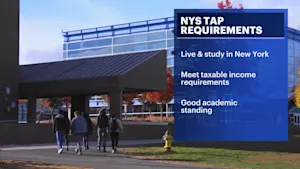The Great Divide - Report: 61% of Long Island schools do not have a Black teacher
The study's findings mean that 80,000 students on Long Island will never see a Black, Latinx, or Asian teacher in any of their classrooms.
•
Sep 23, 2020, 5:23 PM
•
Updated 1,865 days ago
Share:
More Stories
0:27

Newly found Dr. Seuss book to be published next year
4ds ago1:41

Wading River teacher removed from the classroom after making 'disturbing remarks' on livestream
16ds ago2:11

Scholar Athlete: Samantha Heyman, Half Hollow Hills East
18ds ago0:38

Adelphi student accused of using AI on an assignment sues the school
22ds ago0:20

NYS TAP applications open
29ds ago1:56

Islip parents start petition to bring in armed security guards to schools
32ds ago0:27

Newly found Dr. Seuss book to be published next year
4ds ago1:41

Wading River teacher removed from the classroom after making 'disturbing remarks' on livestream
16ds ago2:11

Scholar Athlete: Samantha Heyman, Half Hollow Hills East
18ds ago0:38

Adelphi student accused of using AI on an assignment sues the school
22ds ago0:20

NYS TAP applications open
29ds ago1:56

Islip parents start petition to bring in armed security guards to schools
32ds agoImagine never having a teacher that looks like you? For thousands of Long Island's students, that's the reality, and it has been for some time.
Mae Lane, of Dix Hills, is a retired middle school principal who worked in Brentwood. Lane says the lack of teacher diversity in Long Island schools has gotten worse over the years.
"I remember in the 80s, in the building that I worked in, there were seven Blacks and two Latinas. Just before I retired, there were two Blacks," says Lane.
Two Black teachers may not be many, but it's two more than Lane's granddaughter, Jaelyn McCracken, of Islip, has seen at her school.
A recent report by the National Center for Suburban Studies at Hofstra University found that 61% of Long Island's 642 school buildings do not have a Black teacher. Forty-three percent don't have a Latinx teacher.
The study's findings mean that 80,000 students on Long Island will never see a Black, Latinx, or Asian teacher in any of their classrooms.
Hofstra University's Larry Levy says the lack of diversity comes amid significant demographic shifts in Long Island's overall population.
"Even as Long Island becomes increasingly non-white, the education system is not even coming close to keeping pace," says Levy.
Brandy Scott is the president of the Long Island Black Educators Association. Her organization helps train the teachers of color of tomorrow and says there's a lot of competition for their services.
"The corporate world has embraced diversity two decades ago, and therefore they are competing for our brightest and most skilled students coming out of college and graduate school, and they're offering them a lot of benefits, and a lot of money," says Scott.
Scott believes overt racism in hiring is rare, but says implicit biases often play a big role.
Eastern Suffolk BOCES Superintendent David Wicks agrees and says he's trying to change that.
"We have an initiative looking at our hiring practices. How are we advertising opening our positions within our agency? How are we interviewing or getting resumes for those positions? How are we conducting those interviews?" says Wicks.
Levy, Scott and Wicks all agree - the lack of teacher diversity hurts young minority students who may never see a person in power who looks like them, and young white students who may never interact with an authority figure of color until they reach college, or the workforce.
Lane worries that could result in students believing the worst stereotypes about people who they've never truly interacted with.
More from News 12
0:33

Glen Cove School District replaces gym floors containing high levels of mercury
1:41

Wading River teacher removed from the classroom after making 'disturbing remarks' on livestream
2:11

Scholar Athlete: Samantha Heyman, Half Hollow Hills East
0:38

Adelphi student accused of using AI on an assignment sues the school
1:56

Islip parents start petition to bring in armed security guards to schools
